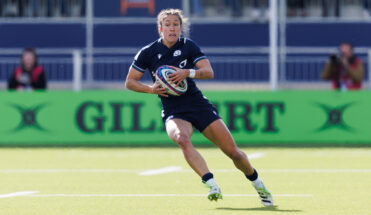IN FOCUS: Exploring Scotland’s grass roots
In the drive to increase rugby’s popularity in Scotland, one of the most compelling arguments is that nothing sells the game better than a successful national team.
That feeling is hard to miss this week, after Scotland Men put their Rugby World Cup campaign back on track with a convincing 34-0 win over Samoa while Scotland Women recorded two victories against South Africa in their first Test matches in the Southern Hemisphere.
Success is priceless. Even the slickest of marketing campaigns can never hope to match the winning feeling when Scotland deliver. The difficulty is that a strategy to grow the game cannot be built simply on the outcome of a fixture.
Efforts to strengthen rugby’s grass roots have been back in the spotlight over the past week, when Scottish Rugby’s 2019-2023 Development Strategy were revealed at BT Murrayfield. Amid concerns about falling numbers of players, it emerged that there are 36,207 people registered as rugby players in Scotland. This represents some decrease on recent years but that historic player number comparisons are not comparing like-with-like. The improved data management system SCRUMS, will ensure that an accurate picture of registered players, how often they play and where will not be available to rugby.
It has been pointed out that the figures do not record how regularly each person is playing rugby, but that was not the intention of the update at this stage of the Development Strategy, and instead the early work has been conducted to give a baseline figure on which the Strategy can be built upon, with the next emphasis on player retention and transition.
The total figure of registered players will be questioned by those who point to the reduced number of senior teams fielded by clubs today compared to 20 or 30 years ago. Evidence to support this point is clear rather than anecdotal, and this particular area of concern is to be addressed although it cannot be fixed overnight. But during those years of change, rugby’s appeal has broadened into other areas, and the sport’s reach should not be measured solely by levels of participation in the senior men’s game when other age groups, the women and girl’s game and new formats are still growing.
In addition, the number of players required to turn out a senior XV has increased significantly from possibly no more than 15 to 20, to requiring a squad of more than 30 once availability is factored in, with different lifestyles and increasing demands on time making it far harder to field enough teams to fulfil the kind of fixtures lists of old. Some clubs are reporting up to 48 players to fulfil one fixture.
Despite that scenario, it remains possible for clubs to strengthen playing numbers. At Montrose, the town’s rugby club did not field a senior men’s team for a couple of seasons, but can report that membership has gone up year-on-year over the past decade. How do they do it?
“We are slightly maverick as a club because we have seen issues coming,” says club president Duncan Campbell.
“We have focussed on participation and not got hung up on winning being the only thing we aim for. We have looked at how to make better people through sport.
“Something like one in 200 children taking part in sport make it to elite level, so let’s focus on the other 99.5 per cent, and their lives in sport.”
It’s clear that Montrose has a strong ethos, and this is augmented by specific strategies designed to attract participants and keep involvement at a healthy level. Its Rugby Achievement Programme, in partnership with local school Montrose Academy, ensures that as well as giving S1 and S2 pupils the opportunity to play rugby, schoolchildren also learn about nutrition, psychology, lifestyle and well-being. “This starts to break any unhelpful stereotypes and emphasises positive aspects of rugby,” adds Duncan.
There has been significant investment in youth rugby, and a pathway – the ‘Montrose Way’ – has been created to guide players from the micros ranks to seniors, thus addressing problems over drop-out.
Community outreach is another key objective. Its main purpose is not direct recruitment, but instead to give local people a ‘rugby experience’. The club is trying to create an environment that people want to spend time in, and at the heart of that is the goal of building a new, community clubhouse at Union Park that will be a multi-sport venue. Their current facility, with two changing rooms and open showers cannot meet the needs of a club that is now putting out nine squads.
The Montrose president was part of a Scottish Rugby contingent which travelled to Iceland earlier this year to witness how football has reaped the benefits of rolling out a world-class coaching system, but also to understand how sport has been used to achieve societal change. The approach is expensive, involving top quality facilities and coaching, but the calculation is that a healthier and engaged population will reduce both healthcare costs and the judicial costs that come with anti-social behaviour.
Duncan has been inspired by the experience of finding Icelandic clubs were at the heart of the community, and reassured that his own club’s objectives are aimed in the right direction.
“We have to tailor what’s being offered to the local community,” says Duncan. “We have to listen all the time, and make it very clear what we are offering. People should feel confident and safe at our club, they should develop and they should get something back.”
There is no one-size-fits-all solution to increasing involvement at Scotland’s rugby clubs, and not all circumstances are the same. But the evidence at Montrose is that decline is not inevitable. There can be another way.
Donald Walker offers a guest perspective as a former Sports Editor and then Deputy Editor of The Scotsman from 1998 to 2019 and is writing a series on rugby.
Tags
Related news

Final Silver Saturday teams confirmed

Inter-city double header as Edinburgh Rugby U16 host Glasgow Warriors U16

Visit a Scottish Gas Net Zero Roadshow at your local rugby club

Lloyd set for milestone cap against Azzurri

Review: U17 FOSROC Academy Festival

Super ‘sleuthing’ traces relatives of Scotland cap

Silver Saturday finalists confirmed – the countdown is on

U17 FOSROC Festival sees regional academy sides joined by Newcastle Falcons

BBC ALBA to broadcast live FOSROC Super Series Sprint matches





